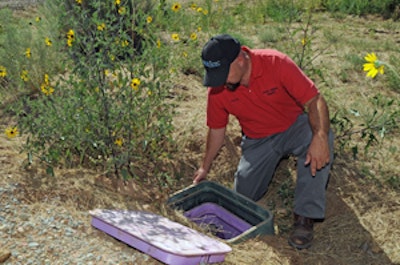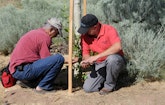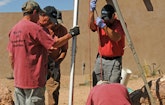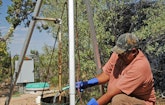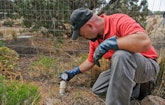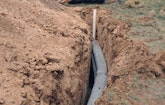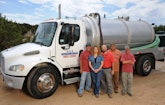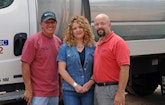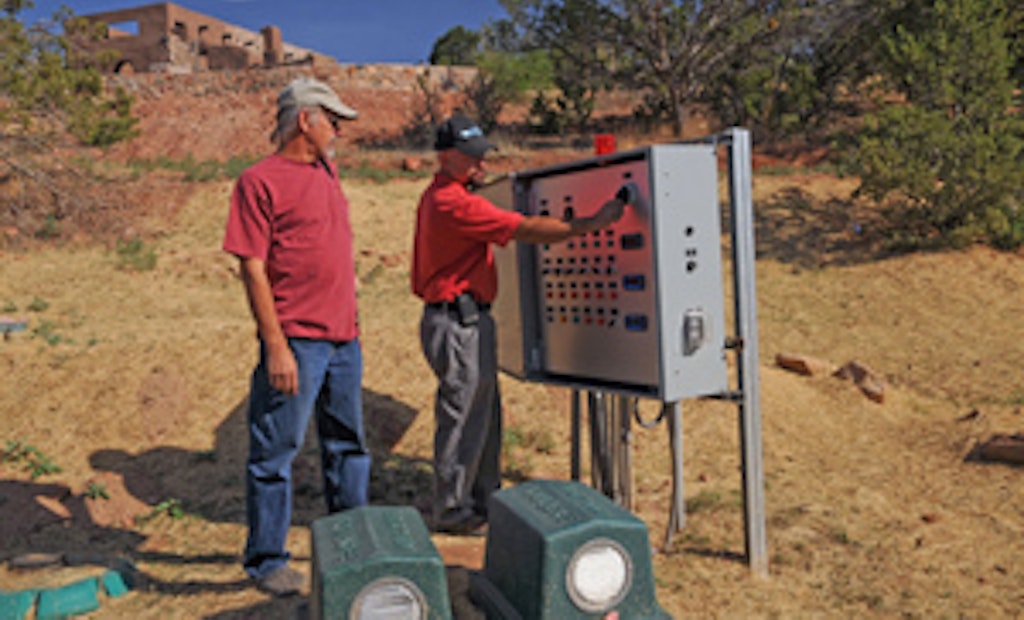
Interested in Alarms/Controls?
Get Alarms/Controls articles, news and videos right in your inbox! Sign up now.
Alarms/Controls + Get AlertsA two-generation installation, pumping and management company in Santa Fe has found opportunities and sustained growth by staying ahead of the knowledge curve.
In this dry, soil-challenged area of New Mexico, where summer and winter temperatures are often at opposite ends of the scale, survival in business depends on mastering an equally broad range of technologies. Matching technology to site to aesthetics, Ralph Baker Dotson, owner of AAA Allied Septic Tank Service, succeeds by continuously acquiring and sharing onsite knowledge across his service area, which covers a 125-mile radius from his home base.
AAA Allied handles tank pumping, system design and installation, and repairs. To accommodate diverse customer needs, Baker Dotson formed Water Management Associates six years ago to provide maintenance, management and operation services. That business focuses on management of advanced treatment systems using technologies such as Geoflow drip systems, SludgeHammer bacterial generators, Koi trickling filters, and a wide variety of aerobic units.
No matter who installed a given system, Water Management will take it on. The business is also a comfortable home for orphaned systems, which often need more intensive care to bring them back to optimal performance before the monitoring mode kicks in.
The businesses can refer work to the other. “We look at the expected type and likely duration of an ongoing relationship when we guide work to one or the other,” says Baker Dotson.
“Because we service a broader range of technologies than we install, we must become more than competent at understanding every technology we encounter. It is usually the orphan systems that bring the greatest challenge, as manuals and parts may no longer be easily located.”
Starting young
Baker Dotson got an early start working beside his dad, Carl, when he was 13 years old. “That first year, I was basically hanging out with my dad,” he says. “But when I was 14, I started paying attention.” When his dad died suddenly, Baker Dotson stepped up and, with his mom, Florence, kept the business going. A few years after high school, he bought out his mom.
“What sets us apart is that we know and understand wastewater treatment and dispersal technology,” Baker Dotson says. “We understand the statewide regulations, and we consistently follow them, along with related manufacturers’ standards.”
Consistency in approach and practice is also something customers want, and that explains why, even in slow times, business for AAA Allied is strong.
AAA Allied works across the spectrum of onsite services. About 35 percent of the business comes from new installation and modifications, 20 percent from repairs and service, 30 percent from pumping, and 15 percent from inspections for real estate sales.
When it comes to inspection, Baker Dotson observes, “The standard is the standard.” He adheres to it whether he’s working for the buyer or seller; in either case, the information he gathers about the system determines his report’s conclusions. “If you want a system passed just to make a sale, you won’t call me,” he says. “If I do my job right, all parties are protected from future loss, and everybody benefits.”
Describing his inspection philosophy, he returns to the critical necessity of understanding the system. “It is easier to fail a system and sell a ‘repair’ than to take the time to discover and understand the hidden system and what its condition is telling you,” he says. A typical inspection details the system for the customer and, if needed, proposes an appropriate solution that fits the technology, the site, and the level of need.
Essential certification
His faith in standards extends to certification for installers, except that here he sees certification as a step in the learning process, not its end. He believes too many installers, inspectors and management service providers see certification or state licensure as a final step.
“The idea that a document lets the holder stop learning is too common in this industry,” he says. “The professionals in this industry want to learn and grow.” As president of the Professional Onsite Wastewater Reuse Association of New Mexico, Baker Dotson has leveraged the association’s respected position, turning it into a kind of soapbox from which to deliver his message of progress to regulators, legislators and industry peers.
The industry benefits from a single statewide set of onsite siting, design and management regulations. “That consistency keeps costs down by avoiding multiple sets of regulation books and the need to say to myself, ‘OK, what county am I in today and what are their regulations on this matter?’” says Baker Dotson.
Education is a two-way street, and AAA Allied employees are as skilled at educating customers as they are working in the field installing, evaluating and maintaining systems. Education begins with a customer’s first phone contact with Gina, office manager and Baker Dotson’s wife. The education doesn’t stop with the final handshake and wave goodbye.
Throughout the relationship, the customer receives a steady stream of detailed information about the site, the system, and how to care for it. Here, too, thorough information sharing is part of every employee’s job description.
Gina joined the business about six years ago. “She could see that I was overwhelmed and decided to join the team,” Baker Dotson says. The first voice customers hear is hers, not a recorded greeting. She can stand toe-to-toe with the other employees in delivering accurate system information to callers. She also shares with her husband the passion for the business that he got from his parents.
Conservative designs
That passion helps AAA Allied deal with the two basic challenges local geography presents for designing and constructing successful systems. Impervious layers in the soil profile obstruct downward water movement on some sites, while on many others, soil and geologic conditions let water move downward too quickly. In either case, soil treatment of the effluent is severely limited. While Baker Dotson occasionally works with nice, level sites with deeper soils, they are the exception.
Understanding customers’ predictable behavior, Baker Dotson makes it a practice to incorporate reserve capacity in most systems. He calls it a “redundancy that anticipates emergencies.” The designs let systems tolerate short-term, heavy-loading events that occur during holidays and family gatherings.
Many designs incorporate features that facilitate later maintenance, or even make system repairs easier. He likes EZflow from Infiltrator drainfield media in the belief that it provides more surface area to support microbial life than does mineral aggregate. He prescribes 1.5-inch low-pressure laterals in each run of media, feeling that provides better distribution.
This also enables easier pipe replacement in case that becomes necessary at some future time. He fits a screw-in end cap at the above-grade terminal end of every lateral. Then, by replacing a cap with a pressure gauge, he can measure pump performance in individual laterals. The screw-in fitting also enables easy access for jetting or vacuum cleaning.
Although not required by regulation, Baker Dotson installs valves at the manifold end of every lateral. “The valve lets us isolate a single lateral, taking it out of service without shutting down the entire system,” he says. “The valve also isolates the lateral for jetting and vacuuming, making individual lateral cleaning more efficient.”
Natural management
The arid conditions in his service area let Baker Dotson reuse treated effluent to support decorative vegetation. When the site’s size, slope and soil conditions limit the absorption area, he can compensate by using plant uptake, aided by the area’s natural high evaporation rate. This approach is especially handy on repairs.
Some reuse areas he has built are the most aesthetically pleasing aspects of an entire property. “Just because we are building a wastewater system, there is no need for it to look like one,” he says.
“We can never take the adequacy of soil renovation or the soils’ water dispersal capacity for granted,” he adds. “That is why we look to vegetation as a water management tool.” Baker Dotson wants plant uptake not simply to remove soil moisture but also to sequester nitrogen in the vegetative material. He believes nitrogen capture is the more important of the two.
When he needs to add plants, he looks first to the site’s natural species, reasoning that more of the same will have the greatest chance of survival. When no plants exist, matching the plants to the landscape is the guiding principal. Pinon trees thrive when watered. He stays away from grasses, which need far too much water to survive.
Baker Dotson dislikes the term “wastewater.” He states, “In this climate, we cannot waste water. But to reuse it rather than disperse it in an absorption area, the water must be treated to secondary standards.” That means BOD and TSS of 30 mg/l or less. To protect groundwater quality, when the aggregate soil interface is less than 10 feet above the seasonal high water table, the discharged effluent must be disinfected.
Limitations of knowledge
Knowledge of technologies and of the industry in general is essential to growth, Baker Dotson believes. “If we are not constantly learning, we are losing ground,” he says. He shares his knowledge freely, knowing that builds a stronger industry and tighter customer connections.
Understanding mechanical components is not enough. “When all the hardware is sound and working properly, yet the system is in an upset condition, I still must be able to determine why it is failing,” he says.
Each employee has focused responsibilities and must occasionally help out in a variety of roles when needed. Orlando Sanchez, who married Baker Dotson’s aunt, is the primary installer and a partner in the business. Steve Sandoval operates the vacuum truck and handles most real estate inspections. James Payne is an installer. Supporting these team members are a 2007 Freightliner truck fitted with a 2,500-gallon vacuum tank, an International two-axle dump truck, a pair of service trucks, and a 2003 Case 580 Super L wheeled backhoe.
In five years Baker Dotson sees a growing and robust business. “Onsite systems are not glamorous, nor are they a luxury,” he says. “They are essential systems that sustain livability, and this business is essential to their continued operation.”
Baker Dotson has always been part of the solution. He has recognized that knowledge is as essential as water for an onsite system to perform properly. “You must constantly outgrow the limitations of your knowledge in order to succeed,” he says. “When you think you know it all, you stop being a resource and become an obstacle to success.”
